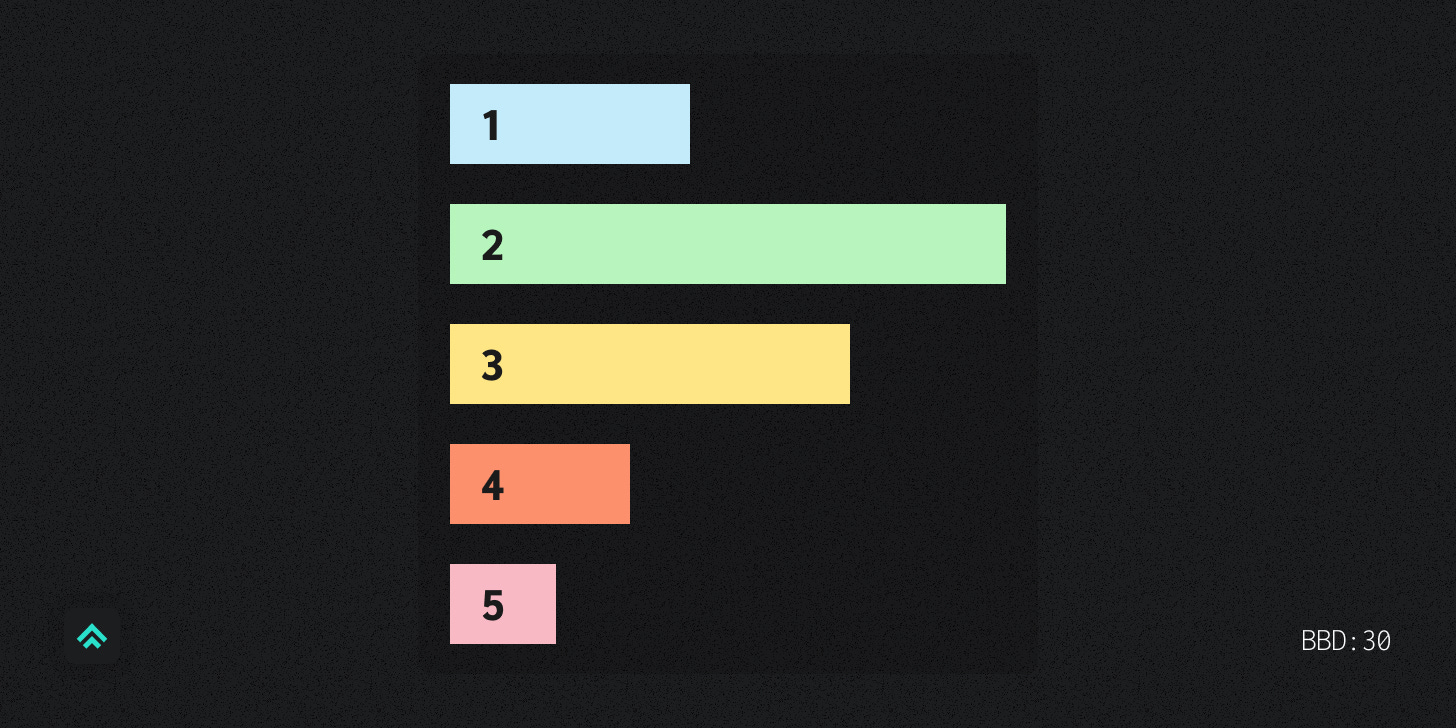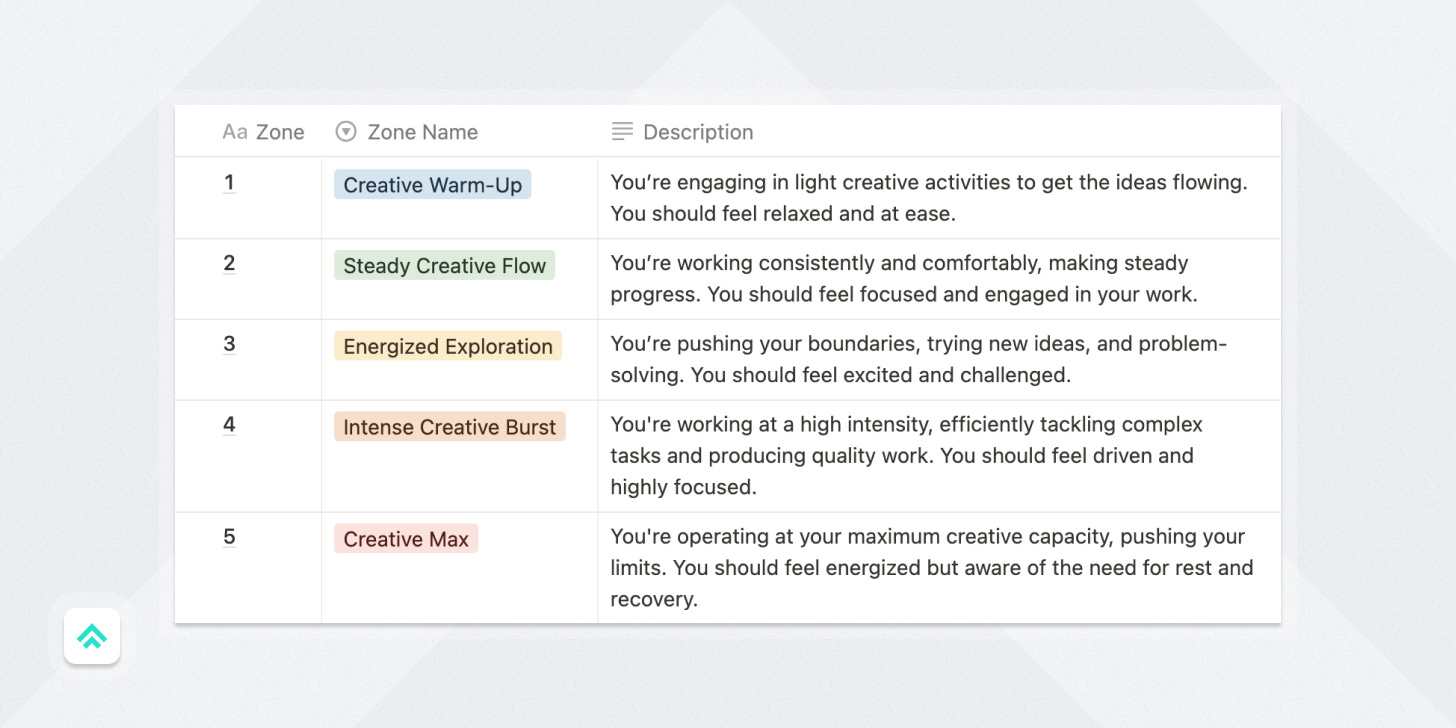The 5 zones of peak creative fitness
Using zone-based training to boost your creativity and unlock your potential
Welcome to the new Better by Designers who’ve joined since last week! If you haven’t subscribed, join 1280+ curious, creative technologists by subscribing here:
Knowledge workers function like athletes — train and sprint, then rest and reassess.
Intro
I have a secret: despite spending so much time writing about design, I do have other interests (gasp! 😱). Today I want to share an idea from my background in endurance athletics that’s been very useful for me when considering how to approach the cadence of my creative work.
Based on the 5-zone heart rate model used in physical fitness training, I put together my own framework for creative fitness. So the flow for today’s piece is:
Background on the concept of training zones
An intro to my 5 zones of creative fitness
An example weekly plan for creative training
Wrap up!
Training zones for physical fitness
A number of fitness methodologies center on building a training program around heart rate-based zones. The zones are divided by the percentage of an individual's maximum heart rate (MHR), with each zone reflecting a different level of exercise intensity and serving a specific training purpose.
The gist of the 5 common zones breaks down like this:
Zone 1: Very Light (50-60% of MHR) - This zone is for warm-ups, cool-downs, and recovery. It helps to enhance overall fitness and promote recovery after hard workouts.
Zone 2: Light (60-70% of MHR) - This zone targets endurance and aerobic capacity. It's ideal for long, steady-state exercises and helps to improve efficiency.
Zone 3: Moderate (70-80% of MHR) - This zone is for aerobic training. It's a strong but comfortable intensity that can be sustained for extended periods.
Zone 4: Hard (80-90% of MHR) - This zone is for anaerobic training. It helps to improve your body's ability to tolerate higher-intensity exercise and enhance your speed and power.
Zone 5: Maximum (90-100% of MHR) - This zone is for bursts of maximum effort. It’s very challenging and should only be maintained for short periods.
Almost any good modern training program will incorporate some flavor of these five zones, though the amount of work prescribed for each will vary depending on what you’re training for. In my case as a distance runner, the goal is to spend the bulk of my time in zones 1 and 2, then add some harder work to spur growth and some lighter work to recover each week.
Okay, I think that’s enough fitness talk for a design blog. You get the idea.
Now for the fun part: how might we apply the 5-zone model to help us get the most out of our creative training?
Introducing the 5 zones of creative fitness
Zone 1: Creative Warm-Up
Just as athletes warm up before their workouts, you should start your creative sessions with a warm-up. This zone is all about getting your creative juices flowing without pressure. You might engage in activities like free writing, sketching, or brainstorming. The goal is to ease into your creative work and allow your mind to wander. Fully divergent thinking.
How you should feel: Relaxed and at ease. This is a low-pressure, low-intensity zone, perfect for sparking inspiration.
Zone 2: Steady Creative Flow
This is your everyday creative work zone. Here, you'll focus on making consistent progress without pushing yourself too hard. Think of it as your creative "sweet spot," where you can comfortably work on your projects for extended periods.
How you should feel: Focused and engaged. You're in the zone, making progress on your creative tasks while maintaining a sustainable pace.
Zone 3: Energized Exploration
In this zone, you'll push your creative boundaries and challenge yourself. You might experiment with new techniques, tackle complex problems, or take risks in your work. The goal is to stretch your creative muscles and grow your skills.
How you should feel: Excited and challenged. You're stepping out of your comfort zone, exploring new ideas, and learning from the process.
Zone 4: Intense Creative Burst
Sometimes, your focus takes you to the deep end, and you find yourself working at an exceptionally high capacity. In this zone, you're producing high-quality work quickly, making significant strides in a short amount of time. It's exhilarating, but it's essential to recognize that these bursts can't be sustained indefinitely.
How you should feel: Deeply immersed and motivated. You're firing on all cylinders, fully absorbed in your creative work.
Zone 5: Creative Max
In this zone, you're working at your maximum creative capacity, pushing your limits to achieve breakthroughs. This high-intensity zone can lead to significant progress in a short amount of time but should be approached with caution. It's essential to balance these intense sessions with rest and recovery to avoid burnout and maintain long-term productivity.
How you should feel: Energized, yet on the edge of your creative limits. You're pushing yourself to the maximum, fully absorbed in your work, but also aware of the need to take breaks and recover.
A hypothetical weekly creative training plan
Let’s continue the thought experiment: Based on the 5 creative zones, what might an idealized weekly “training plan” look like for writing this newsletter? It is an endurance sport after all 😅.
Some things I want to optimize for:
I want to publish Mondays and Thursdays
I want to build a foundation every day (I’ll take days off as needed, but typically I want to do something every day)
I want the standard focused work time to be from 2-5ish hours per day (the equivalent of a productive morning)
I need to be mindful of balancing my energy
Plan Summary
I start each day with a warm-up to get my creative juices flowing, adjusting the intensity based on how I feel, and never relying on inspiration alone. I consistently build my creative base by focusing on Zone 2 flow. On Wednesdays, I incorporate a mid-week Zone 3 challenge, which I balance with a lighter day on Thursday. Saturdays involve a mix of Zones 2-3, combining focused preparation with standard work. The week concludes with a long, hard push on Sundays, dedicating myself to more intense creative work. However, I reserve Zone 5 for special occasions, such as leading up to a new product release or other significant events, rather than incorporating it into my routine.
Plan Detail
Monday
Zone 1: Creative Warm-Up (15-30 minutes): Start the week with light activities to collect inspiration and spark new thoughts.
Zone 2: Steady Creative Flow (2-3 hours): Dive into my main creative tasks, curating ideas and writing short segments while working at a comfortable and consistent pace.
Tuesday
Zone 1: Creative Warm-Up (15-30 minutes): Review Readwise highlights and copy over any quotes that spark ideas.
Zone 2: Steady Creative Flow (2-3 hours): Continue my regular creative tasks, maintaining focus and engagement.
Wednesday
Zone 1: Creative Warm-Up (15-30 minutes): Morning pages style journaling.
Zone 3: Energized Exploration (2-3 hours): A higher intensity session to prep The Creative MBA for Thursday's release.
Thursday
Zone 1: Creative Warm-Up (15-30 minutes): Free writing on any existing topic in my notebook.
Zone 2: Steady Creative Flow (1-2 hours): A bit easier than usual, to recover some from yesterday’s more intense burst.
Friday
Zone 1: Creative Warm-Up (15-30 minutes): Figma design asset ideation.
Zone 2: Steady Creative Flow (2-3 hours): Back to business as usual, focused on my regular creative tasks at a comfortable pace.
Saturday
Zone 1: Creative Warm-Up (15-30 minutes): Warm-up of choice.
Zone 3: Energized Exploration (1-2 hours): An extra push of focus to ensure things are outlined and ready for Sunday’s writing, editing, and publishing prep.
Zone 2: Steady Creative Flow (1-2 hours): Move ahead on other ideas or tasks that seem important but take less focus.
Sunday
Zone 1: Creative Warm-Up (15-30 minutes): Warm-up of choice.
Zone 4: Intense Creative Burst (3-4 hours): Finish the week with a good, hard session to complete Monday’s post.
Zone 1: Creative Cool-Down (30 minutes): End the week with a low-pressure reflection on how things went and prepare for the next week.
“Train and sprint, then rest and reassess.”
When talking about physical fitness, people have no problem understanding that an athlete should include both hard workouts and recovery days in their training program. It seems obvious that this approach helps athletes optimize their performance, improve their skills, and reduce the risk of injury and burnout. However, when talking about creative fitness, people still tend to think that it behaves differently; it doesn’t.
By planning for the 5 zones, we can train our creative skills in a systematic and balanced manner, similar to how athletes train for physical performance. We can:
Maximize time spent in creative flow and energized exploration (Zones 2 & 3)
Sprint when required, by engaging in intense creative bursts (Zones 4 & 5) to achieve high-quality output in a shorter time
Prime the creative pump by engaging in low-intensity creative activities (Zone 1)
Rest, recover, and reassess. Take breaks and reflect on our progress, making adjustments to better align with our creative goals (Zone 1)
I believe that adopting this kind of mindset for creative work can lead to better productivity, personal growth, and a healthier work-life balance. While it’s just based on my personal experience, the overall mindset has held up across my many endeavors, from design and development to music and writing, and of course endurance athletics. I hope you find it as useful as I do!
If you got a little value from this post, consider subscribing, sharing, or following me on Twitter. If you got a lot of value, consider using Substack’s pledge feature to support my work with a paid subscription in the future. Either way, I appreciate you!









